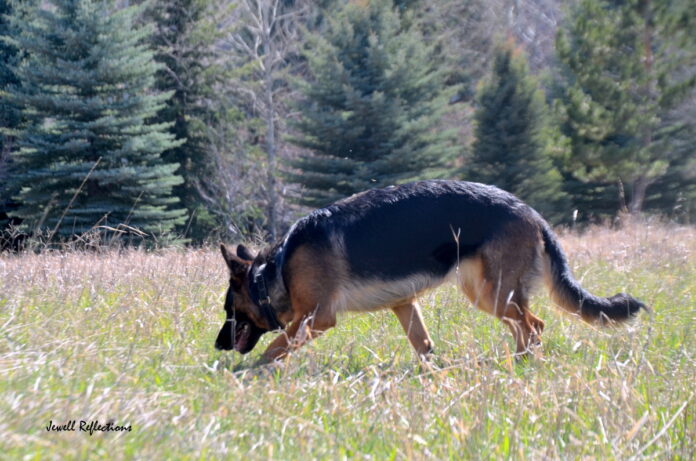By Fran Jewell
Everyone walks their dogs. Many take advantage of that time to catch up on phone calls or chatting with fellow walkers. Many times our walks turn into “our” walks instead of a walk for the dog. That can be a good thing, too. It can be the only break in an otherwise stressful day for us. I am always refreshed after taking a walk with my dog(s).
We can ramp up those walks for our dogs, tiring them out a little faster and giving them a job to do. This is especially important for some of the really high-energy dogs like border collies, Aussies, and almost all of the hunting breeds. In fact, this enrichment activity is good for EVERY dog! It can help the shy or fearful dog. Old dogs still have this instinctual skill that can keep him so happy for a very long time. Dogs that like to run off looking for trouble can benefit from this activity. Even the perfect dog will enjoy his walk even more so when you incorporate this activity.
What is it? Using your dog’s nose! The dog’s nose is so beyond what any of us can even imagine. It is their natural ability for survival. We think what dogs really need is playing with other dogs but, given a choice, many dogs will choose using their nose over play with another dog. Notice I said many, not ALL. I did search and rescue with two of my air-scent dogs for almost 10 years. When you see a dog find a few hairs on the ground 100 feet away or a button in a five-acre field, you begin to understand just how keen that survival skill of scenting is.
How do we incorporate that into a walk? Finding odors start at home. First, hide a few pieces of stinky treats around your home; under a chair, behind a plant, or even slightly under a rug. Attach a word to that as your dog hunts for the food. say either “go find it” or “search.” Say the word when your dog FINDS the treat. Soon, he will attach that scenting/searching behavior with the word and then it can become a command.
Next, plant a few treats in the yard for your dog to go find. Help him by pointing to it if he doesn’t find it right away.
Now, if you have a really fast, nosey dog, you can place treats in a small container, such a clean Altoids box with a few holes punched in it. I am always looking for small containers to hide treats in. But, the container must be big enough that your dog cannot swallow it. You can even use an old wallet, or small purse you get from a thrift store. I used to use those when I was training my search-and-rescue dogs to find articles.
On your walk, before you let your dog out of the car, walk along the route you plan to take and drop a container here or there. As you walk, say your “find it” or “search” command so your pup knows to start using his nose. It is best if you walk somewhere that there are not many other dogs that will find the container before your dog does. You can also do the same game in your backyard. When your dog finds the container, teach him to sit while you get the treat out and then keep the found tin in your pocket for the next walk.
Be sure to remember where all the containers were and pick them up. We don’t want wild critters attracted to the areas you walk by rewarding them with food!
When I did search and rescue, every walk was about finding a wallet, a sock, or a glove or any other object that had only human scent on it. But, my dogs were taught to find the human scent for search and rescue. Even now, my tracking and pet dogs LOVE to find objects!
Making your walk more challenging for your dog will bring you closer to your dog and enrich both of your lives. It can keep the wandering dog from running off. It can help the overly-energetic dog be more tired and easier to live with. Be creative about what you can add for him to search. Use different containers, different food, and different places. This will guarantee more fun for both of you when you discover just how incredibly smart your dog is!
Happy hiking!
Fran Jewell is a dog behavior consultant, NADOI-certified instructor and vice president. She owns Positive Puppy Dog Training LLC and can be reached at (208) 721-7221.



